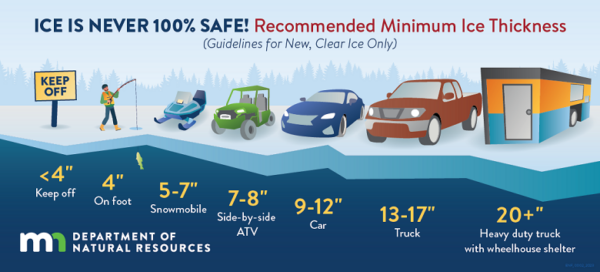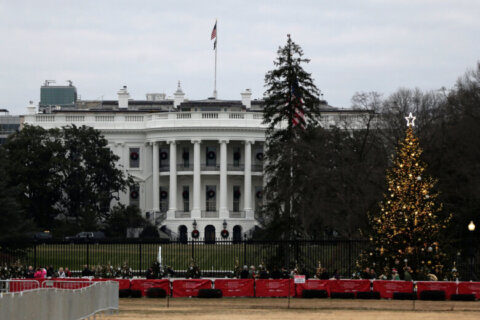The record cold Christmas Eve and continuation of the below-average temperatures through the early part of this week have created a layer of ice on the area’s ponds and lakes. Even though we’re headed into a warm cycle through early to mid-January, we’ll revert to more cold weather later this winter — but that won’t make frozen ponds and lakes safe for recreational purposes like skating.
Just days ago, Prince William County Police identified a 19-year-old Falls Church man who died on after falling through the ice at a Haymarket pond on Christmas Eve.
As D.C.’s Lincoln Memorial Reflecting Pool froze and became visually tantamount to vast, gorgeous ice skating rink, some local residents could not resist going for a skate recently — although the National Park Service expressly forbids it.
Monitoring frozen bodies of water
There are several other things to keep in mind this winter when it comes to ice safety surrounding lakes, ponds, rivers and other frozen bodies of water.
Ice must be at least 4 inches thick to even consider walking on it safely. Ice thickness of this magnitude does not happen after a few days of bitterly cold temperatures.
Five to 7 inches of ice on a lake makes it safe to drive an ATV or snowmobile on. Ice thickness of this magnitude will take at least two weeks of well-below average temperatures.
Clear, transparent ice is safest because it is pure frozen water from sustainable cold weather. This type of ice will appear blue or black as you look down into the pond or lake.

Milky-looking ice forms from the freeze/thaw cycle of snow on top of the lake from recent wintry weather. Snow lying on a pond or lake will keep the temperature of the lake warmer and slow the freezing process. Therefore, a milky-looking pond is more unsafe than clear ice.
Ice never freezes uniformly on a pond, so it could be a foot thick in one spot and only an inch thick a few inches away.
Frozen streams with water flowing over or through them are unsafe for any activity.
Ice that forms on the periphery of a windy river is more unsafe because water on this side of the river flows faster and thus the ice that forms here is weaker.
Cracking ice forms because of the freeze/thaw cycle of the ice as temperatures fluctuate but doesn’t necessarily mean the ice is more or less dangerous.
If you can see fish swarming in a frozen lake or pond, that is a sign of weaker ice because fish will help bring warm water up from the bottom of the water body.
If you really want to know the ice thickness, tools such as chisels, an auger, cordless drill or a tape measure can help.
A consistent cold pattern does not ensure the frozen lake or pond is safe. The sun angle, time of the year (early and late season frozen lakes and ponds are unsafe), water depth (a shallower lake or pond will see increased ice thickness and thus be safer to walk on), wind (strong winds will prevent ice from developing readily on ponds and lakes) and currents (stronger current keeps water from freezing) are factors that go into ice thickness.
A case for skating in the National Mall?
Noah Mitchell grew up in the Capitol Hill neighborhood and began skating at 3 years old. On Monday, as he enjoyed some free time away his studies at the University of North Carolina, Mitchell headed down to the Reflecting Pool to skate after seeing social media posts of others attempting the same thing. After monitoring the temperatures, he texted a friend and the pair headed down to the National Mall.
“We get there, skate for a while, take probably 30 minutes or so,” Mitchell said. “Then the National Park Service come over say ‘hey, you know, by the way, it is illegal.'”
The park ranger told Mitchell that while he could not detain him, U.S. Park Police officers can arrest anyone skating on the Reflecting Pool — which is approximately 18 inches deep around the perimeter and slopes to a depth of 30 inches in the middle, according to the National Park Service. Five minutes later, an officer on a motorcycle told the Capitol Hill native and his friend to leave.
It had to be done pic.twitter.com/MOI8g12gwT
— Noah (@noahmtweets) Dec. 26, 2022
When asked whether he should have been allowed to skate there, Mitchell said that being on the pool skating was special and a reminder of how much D.C. is home to him. He added that he wished federal and city officials could come together to allow people a chance to skate, giving an experience that only those in cold-weather states near bodies of water experience every winter.
The ability to skate in the National Mall — in a body of water no bigger than an NHL ice rink — was quite fun and Mitchell believes it shouldn’t be against the law.
“It’s a third of a third of a mile long; it’s just beautiful … You don’t get tired of the view of the Capitol, the Washington Monument and Lincoln Memorial, and the trees all around, the plains landing,” he said. “It was really exciting, and I would have been happy if I lasted one minute there. I’m glad we got half an hour before they asked us to leave.”
WTOP’s Dick Uliano contributed to this report.








